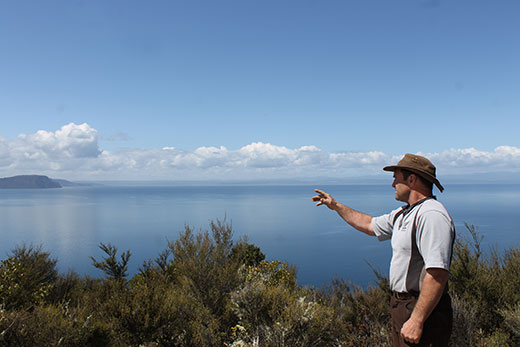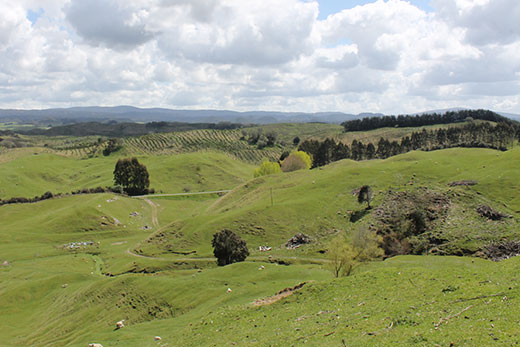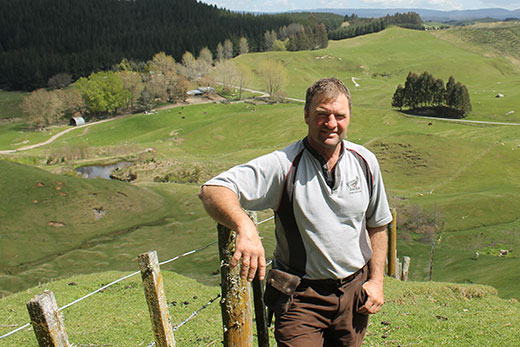Alex and Anne Richardson’s property was once surrounded by other farms – but today it’s pines, not sheep and cattle, which largely populate their part of Taupo’s Western Bays.

Alex Richardson believes in the need to protect Lake Taupo, but doing so comes at a cost to his farming business.
Grand parenting
“This reflects the fact our property is below the catchment average.
“This one of the inherent disparities of the grand parenting system in that farms are allocated their NDAs based on a snapshot in time meaning neighbouring farms, one a traditional breeding property and the other say with winter grazing dairy cows could achieve 15kg and perhaps 23kg respectively.
“That’s a difference of 8kg and based on a $300/kg value represents $2400/ha. It is a bitter pill to swallow.
“Over time, as more farms come under similar caps, I think the stigma will reduce and that will probably be reflected in land values too.”
Anne says the resource consent to farm requires the farm’s accounts to be submitted to Waikato Regional Council annually to assess production and stocking levels to ensure they remain within the cap.
“We are also required to pay for council to audit our books; and recently had to pay to have the person auditing the books, audited too.
“It doesn’t make sense to me as if the Inland Revenue Department decides to do an audit, they don’t charge you to do it,” says Anne.
Anne and Alex accept the need to protect the quality of the lake’s waters and agree those who contribute to nutrient leaching should play their part in reducing that impact.
Alex is now chairman of the Taupo Lake Care group of farmers and land owners, set up to work with council when the changes to land use rules were first mooted.
The science around nitrogen leaching says, in part, that nitrogen, particularly from urine excreted by livestock, rapidly eventually finds its way into ground water, and so the lake.
Bush reserve
“There is a reserve of native bush between our property and the lake shore, we also have around 28ha which was retired from grazing in the late 1970s early 1980s as part of a scheme to protect the lake; so early on we thought we were doing everything required to provide a buffer between our farm and the lake,” says Alex. He wonders what impact forestry will have long-term on water quality. Currently, nitrogen leaching from forestry has been assessed at 3kg nitrogen per hectare, compared to 15 kg for the Richardson farm.
“However, not only is pine pollen rich in nitrogen but you only need look around the catchment to see how prolifically broom flourishes within forestry blocks and retired areas. The nitrogen leaching under broom is uncertain but there’s some conjecture that it’s considerately higher than our 15kg.
“Fifty years down the track will these actions be achieving the desired results? I also wonder what impact that will have as the trees mature and wind blows pollen into the lake.”
The changes to farming around Lake Taupo have come about since the Waikato Regional Council enforced Variation No. 5 - Lake Taupo Catchment in 2011.
The new policy and rules aim to manage land use in the catchment, with some farming practices controlled or requiring consents. It also contains tighter controls for new urban development in the Lake Taupo catchment.

Pine trees have been planted on once productive farmland surrounding Bracken Brae on Lake Taupo’s Western Bays.
Buy nitrogen
New rules in the variation include limits on the annual average amount of nitrogen leached from rural land use activities; and dairy and drystock farming now require resource consents.
The rules allow nitrogen offsetting between properties, which council says is to provide flexibility for landowners to meet the new rule requirements.
In effect, if farmers want to exceed their nitrogen use, they must “buy nitrogen” from owners whose land use generates less nitrogen than is permitted under the rules – in other words, nitrogen trading. Currently, nitrogen sells for $300 per kilogram.
As part of the process to change land use and reduce nutrient leaching, an $80 million fund was set up to buy land in the catchment.
Although many of their neighbours decided to approach the Lake Protection Trust and offer their farms for sale, Alex and Anne didn’t.
It’s true Anne was tempted but Alex’s love of the land he’s worked so hard to farm well, his livestock, and the beauty of the Western Bay’s location is so strong he couldn’t do it.
“I think it would be tragic if all this was planted in pines and no one could ever again enjoy this stunning view,” says Alex, as he stands overlooking the lake.
He’s also sorry to see what were productive farms converted to forestry, much of it now owned by overseas superannuation funds.
Pines cast long shadows and it was to prevent the forestry depriving part of the farm of afternoon sun that Alex and Anne approached the forestry company to see if they could purchase 18.5ha on their road frontage.
This was agreed to and done, although with only 5kg of N, which doesn’t allow for any increase in stock.
Deep gully
Bracken Brae, a former Lands & Survey ballot block, begins from Hingarae Rd and rises steeply to a flat plateau.
About 20 per cent is steep country, with the remainder flat and rolling. The farm is bisected by the deep gully, and it’s along that rim that during the years Alex’s planted 28,000 trees, many exotics, including timber trees and others that provide food for native birds.
The farm runs 1406 mainly Perendale ewes, 436 hoggets, 20 rams, 121 Hereford cows, 52 yearling heifers, 59 yearling bulls, 45 two-year-old bulls and four breeding bulls.
“A lot of the decisions we make for our farming systems are done for personal satisfaction, hence having breeding cows is largely due to the fact I get a lot of pleasure from farming them rather than the economic returns being the primary consideration,” says Alex.
“In saying that, the demand for bulls from the dairy industry do make the Herefords a bit more lucrative than your standard beef cow operation.
“I love the challenge of continually trying to improve performance in our ewe flock and if you achieve your aims, this of course equates to improved returns.
“I like Perendales, their hardiness and spirited [some would say flighty] nature suits me and they do well in this land and climate.”
Alex is open to introducing other genetics to improve performance and put a shot of East Friesian through the flock 10 years ago.
“This had a positive impact on fertility and milking ability particularly in the hoggets but a negative impact on hardiness and wool quality.
“I think every breed has its strengths and weaknesses; it’s all about achieving the right balance to suit your purposes.”
At about 520 metres above sea level, winters can be harsh with frequent frosts and occasional snow, so hardy animals are essential.
Keeping the stock well-fed takes careful management, but fortunately the farm has sufficient flat land and good grass growing areas to make its own silage.
Cycle trail
Because of its location the Richardson farm became part of the access way for men and machines building the Western Bay’s section of the cycle trail called the Great Lake Trail, which opened in April.
“It’s a fantastic project and we were proud to be part of it.”
As to the future – Alex believes hard though the caps are, ways will be found to continue to farm profitably and sustainably.
That’s one of the reasons he’s keen to increase his lambing percentages from 143 and this spring has enjoyed some success achieving 154 per cent.
“The weather has played a big part but I’d say a large part of our improved lamb survival came down to better ewe nutrition.
“This is due in large part to the decision made, while we were a Beef & Lamb monitor farm, to put our calving date back a month.
“This freed up feed at a critical time for the ewes.”
Hoggets lambing has been practised for some years and he’d also like to achieve better performance there.
“It is vital we protect our environment not only for future generations but also because it’s more and more becoming an important marketing consideration, which we could perhaps use to greater benefit.
“But we need to set realistic achievable targets remembering that economic sustainability –both for the individual and the nation – is a major consideration.”



0 Comments
Leave a Comment